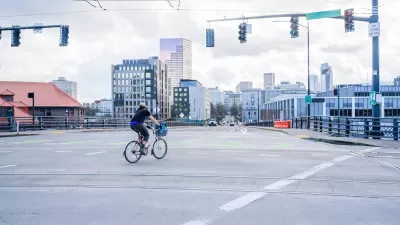A new report from the AAA indicates that American motorists encounter damage from potholes three times a year, with each incident costing an average $300 to repair. Middle and working class drivers feel the pinch disproportionately.
The AAA survey serves as yet another reminder that rather than laying more asphalt for new roads, governments at all levels need to prioritize maintenance and repair—referred to as a "fix-it-first" approach. The damage caused by poorly roads costs Americans an extra $3 billion in annual auto repair costs.
"AAA cautions drivers to remain alert to avoid pothole damage, and urges state and local governments to fully fund and prioritize road maintenance to reduce vehicle damage, repair costs and driver frustration," states the AAA press release.
The problems range from tire punctures and bent wheels, to more expensive suspension damage.
Poorly maintained roads have a disproportionate effect on middle and working class drivers—something critics of gas tax increases who are quick to cite the "regressiveness" of the gas tax might consider.
According to AAA’s survey, middle- and lower-income individuals are the most worried about potholes, with the majority of respondents in households having annual incomes under $75,000 expressing the highest levels of concern over damaged roadways. This is likely due in part to the financial impact, as pothole damage can lead to expensive and extensive vehicle repairs.
While the responsibility for well-maintained public roads lies squarely with government agencies, there are steps motorists can do to lessen damage to their vehicles. See AAA's tips to drivers. Recommendations are also listed in their fact sheet [PDF] on the survey.
Finally, no mention of damages to bicycles, but as any cyclist knows, they feel, quite literally, the effects of poorly maintained roads. Cycling Weekly (UK) prepared a "Guide to tackling potholes on a bike."
FULL STORY: Pothole Damage Costs U.S. Drivers $3 Billion Annually

Maui's Vacation Rental Debate Turns Ugly
Verbal attacks, misinformation campaigns and fistfights plague a high-stakes debate to convert thousands of vacation rentals into long-term housing.

Planetizen Federal Action Tracker
A weekly monitor of how Trump’s orders and actions are impacting planners and planning in America.

San Francisco Suspends Traffic Calming Amidst Record Deaths
Citing “a challenging fiscal landscape,” the city will cease the program on the heels of 42 traffic deaths, including 24 pedestrians.

Defunct Pittsburgh Power Plant to Become Residential Tower
A decommissioned steam heat plant will be redeveloped into almost 100 affordable housing units.

Trump Prompts Restructuring of Transportation Research Board in “Unprecedented Overreach”
The TRB has eliminated more than half of its committees including those focused on climate, equity, and cities.

Amtrak Rolls Out New Orleans to Alabama “Mardi Gras” Train
The new service will operate morning and evening departures between Mobile and New Orleans.
Urban Design for Planners 1: Software Tools
This six-course series explores essential urban design concepts using open source software and equips planners with the tools they need to participate fully in the urban design process.
Planning for Universal Design
Learn the tools for implementing Universal Design in planning regulations.
Heyer Gruel & Associates PA
JM Goldson LLC
Custer County Colorado
City of Camden Redevelopment Agency
City of Astoria
Transportation Research & Education Center (TREC) at Portland State University
Jefferson Parish Government
Camden Redevelopment Agency
City of Claremont





























